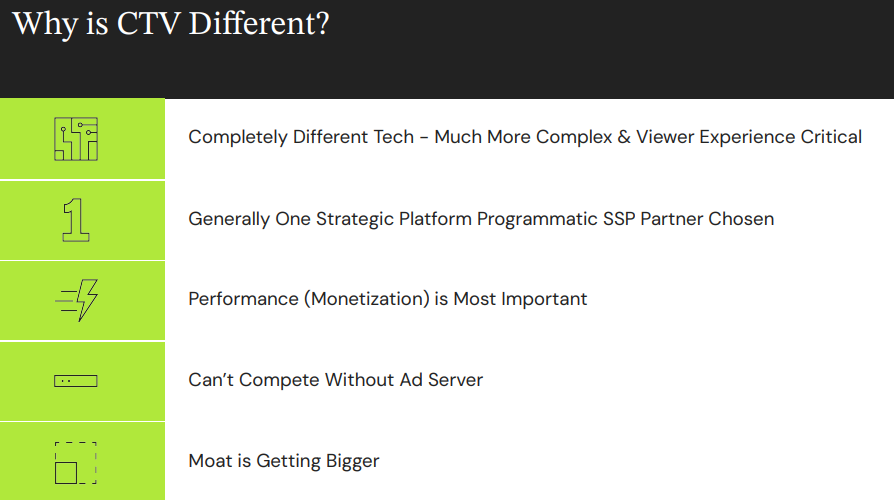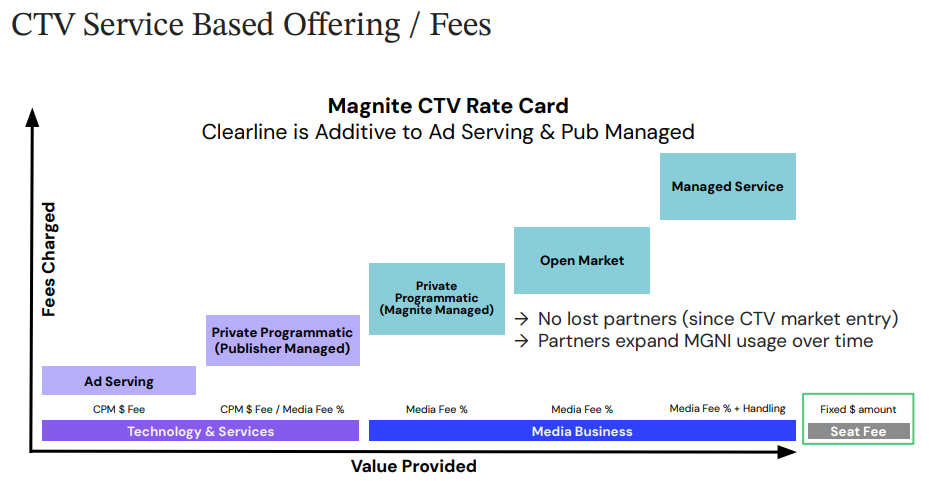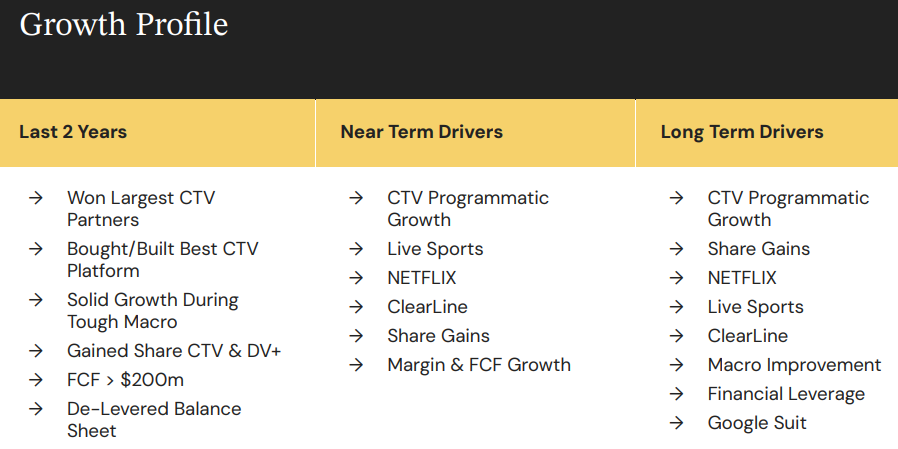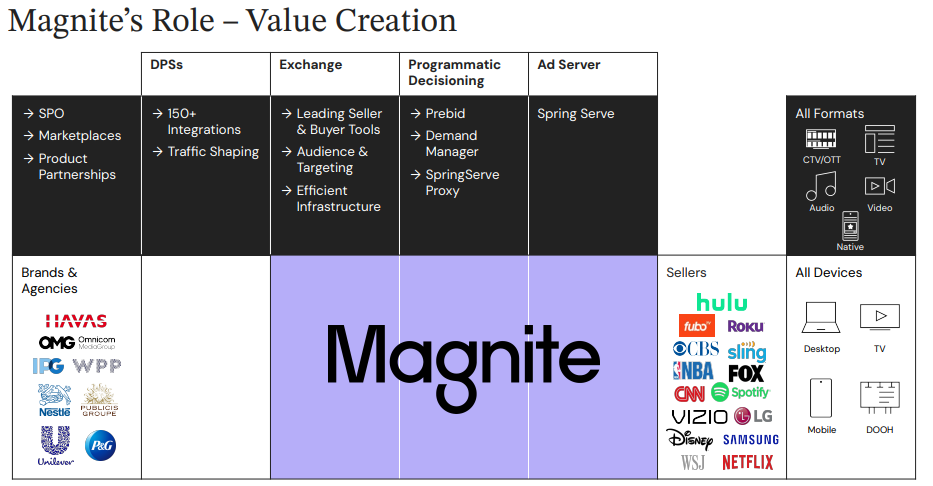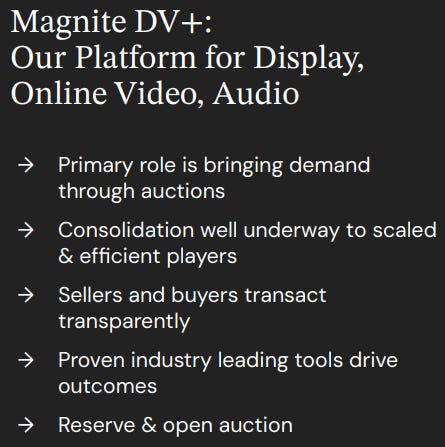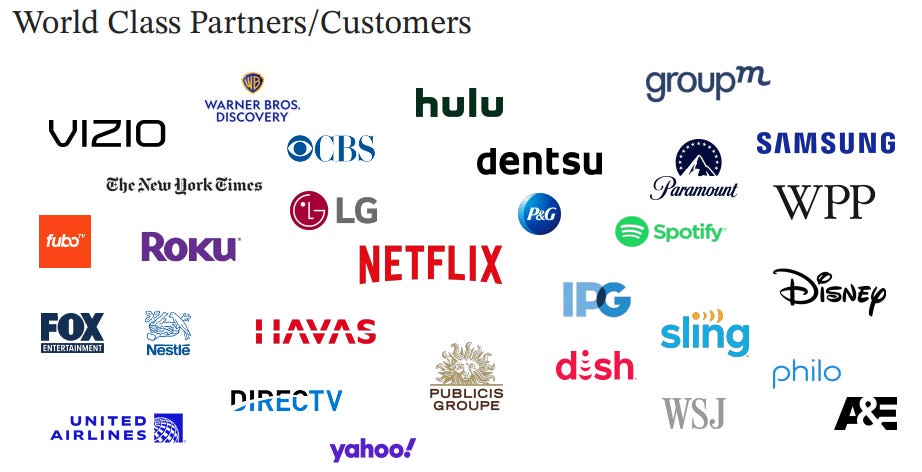A Primer on Magnite
Magnite (MGNI) is the leading independent SSP in CTV and digital video, benefiting from secular tailwinds in both markets and the growth of programmatic advertising.
In CTV, it has amassed an A list of customers, including Roku, LG, Warner Bros. Discovery, Fox, Vizio, Walmart, and Netflix.
It is also benefiting from regulatory changes that make life harder for walled gardens Google, whose exchange controls over 60% DV+ market.
Magnite maintains strong EBITDA margins, robust cash flow, and manageable leverage, supporting a positive long-term outlook.
Here is a Primer, which is intended to get a grip on the moving parts, stay tuned for our upcoming Quick Take, which discusses the financials and the prospects for the company.
Company Overview
Magnite, Inc. provides technology solutions for the automated purchase and sale of digital advertising inventory. It positions itself as the world's largest independent omni-channel sell-side advertising platform (SSP) and the largest independent programmatic CTV marketplace. The company offers a single partner for global transactions across all channels, formats, and auction types.
Magnite's platform features applications and services for both sellers (publishers) and buyers (advertisers, agencies, demand-side platforms or DSPs), facilitating intelligent decision-making and automated transaction execution at scale through a transparent, independent marketplace. The platform processes trillions of ad requests per month, providing buyers with a scaled, independent alternative to "walled gardens". Magnite operates worldwide, with established presences in North America, Australia, and Europe, and developing presence in Asia and South America.
As of December 31, 2024, Magnite had 905 full-time employees. Its team comprises diverse expertise across data science, infrastructure, software development, and sales/buyer-side leadership. Magnite has personnel and operations in various countries globally.
Industry Trends
Magnite identifies several crucial trends shaping the digital advertising ecosystem:
Continued Shift Toward Digital Advertising: Consumers are rapidly moving to digital mediums and expect seamless content consumption across devices like computers, tablets, smartphones, and CTVs. Magnite anticipates continued growth in digital ad spending as digital content consumption proliferates.
Shift towards Programmatic: The complexity and scale of the digital advertising ecosystem necessitate automated solutions. Programmatic advertising, which automates planning, buying, selling, and measurement, allows for impression-by-impression transactions using real-time bidding and advanced data/identity solutions for better targeting. This includes biddable auctions and various reserve auctions, such as programmatic guaranteed deals.
Convergence of TV and Digital: CTV viewership is growing rapidly, accelerating the transition from linear TV. Many streaming services have adopted ad-supported or hybrid models. Magnite expects brand advertisers to shift budgets from linear to CTV and CTV sellers to make more inventory available programmatically through biddable auctions. Magnite plans significant investments in CTV growth initiatives, expecting it to be a major driver of future revenue growth.
Identity Solutions: While programmatic traditionally used third-party cookies for targeting in desktop/mobile, privacy concerns have led to their restriction or elimination. Google's recent shift to opt-out features for cookies and investment in Privacy Sandbox could lead to short-term uncertainty and potential CPM decreases. In the long term, Magnite believes this shift is positive, moving towards a seller-enabled identity model where publishers with direct consumer relationships can better leverage first-party identifiers. This model already largely exists in CTV, where third-party cookies are not used. Magnite is well-positioned to lead this shift due to its scale and expertise in CTV and continues to invest in identity and audience solutions.
Supply Path Optimization (SPO): Buyers are consolidating vendors to find cost-efficient paths to procure media, aiming to increase the proportion of ad spend on "working media" and improve ROI. Magnite believes it is well-positioned to benefit from SPO due to its transparency, broad/unique inventory, buyer tools (like ClearLine), traffic filtering, and brand safety measures.
Header Bidding and Data Processing: Header bidding, a technique for simultaneous inventory offers to multiple ad exchanges, is widely adopted in desktop/mobile but less so in CTV. It creates technical complexities and a significant increase in ad impressions, which can raise costs. Magnite continuously works to increase its platform's operational efficiency. Its ad server offers a unified programmatic demand solution for CTV, leveraging its SSP capabilities and connecting with third-party demand.
Competitive Strengths
Leadership in CTV: The Magnite Streaming platform is purpose-built for CTV sellers, with significant investment in relationships and a specialized team. It offers tools that translate linear TV practices to programmatic, such as ad podding, dynamic ad insertion for live streaming, audio normalization, frequency capping, and creative review. The combination of Magnite Streaming and its ad server offers publishers an independent full-stack solution against "walled gardens" for yield management.
Scaled Omni-Channel Platform: Provides value to both buyers and sellers. Buyers get a single partner across CTV, mobile, desktop, and formats like video, display, and audio. Sellers gain a one-stop-shop for digital advertising across all properties, with access to large automated buyers and impression-by-impression sales flexibility. This creates a self-reinforcing network effect.
Reserve Auctions and Deal Management: Supports direct deals and private marketplaces, particularly important for premium CTV inventory, allowing sellers tighter control and automation benefits.
Big Data Analytics and Machine-Learning Algorithms; Bid Filtering: Utilizes a big data and machine-learning platform to derive insights from vast data repositories, constantly improving matching quality. This fuels bid filtering technology to block non-monetizing traffic, enhancing ROI for buyers and revenue for sellers, creating a dual network effect and managing high ad request costs.
Identity Solutions: Offers tools enabling sellers to create audience segments from first-party data, increasing inventory value. It integrates with third-party data, attribution, and identity vendors. The recently launched Magnite Curator Marketplace allows buyers to create custom marketplaces with curated inventory enriched by first-party or third-party data.
Header Bidding and Demand Manager Solutions: Integrated with major header-bidding standards, including Prebid.org (which Magnite co-founded), Google, and Amazon. Provides a software solution called Demand Manager to help desktop and mobile sellers manage header-bidding inventory.
Transparency and Controls: Employs a simple, transparent fee structure based on a percentage of ad spend. Clients have control over supply hierarchies, price floors, and ad category lists, with detailed analytics to monitor buying patterns.
Self-Service Model: Allows for efficient scaling and faster business growth relative to sales and support, achieving a high degree of operating leverage.
Buyer Tools: A suite of tools to help buyers discover and curate inventory, append data, and improve ROI. Includes agency marketplace tools for private label marketplaces, custom auction packages, audience tools, and a deal discovery platform. The ClearLine product is a self-service programmatic solution providing direct access to premium CTV and video inventory, maximizing working media spend and improving workflows.
SPO and Demand Generation: Cultivates direct relationships with brands and agencies to increase revenue opportunities for sellers. Enters SPO agreements with major agency holding companies for custom integrations and volume-based discounts, providing sellers with access to differentiated demand.
Independence: Fully aligned with publisher interests, as it does not own media properties that compete for ad spending. It also avoids conflicts of interest by not offering a dedicated demand-side platform.
Growth
Focus on CTV: Continued investment in technology, sales, and support for CTV, particularly enhancing features for live event monetization (e.g., sports) with products like Live Stream Acceleration.
Supply Path Optimization: Capitalizing on SPO trends to capture market share and increase ad spend volume on its platform.
Identity Solutions: Taking a leadership role in shifting to a seller-powered identity model that leverages first-party data, investing further in identity and audience solutions.
Increase Efficiencies on Exchange: Continuously improving operational efficiency through traffic optimization and bid filtering technology to reduce costs for itself and buyers, making the platform more attractive.
Increasing Seller Inventory: Adding new high-quality sellers and expanding existing relationships, especially in CTV, through direct relationships, SpringServe ad server adoption, custom integrations, and header bidding.
Expand International Footprint: Expanding its global presence and investing in sales, marketing, and infrastructure to support growth in international programmatic advertising markets.
Continue to Innovate and Enhance Platform: Developing new features, ad formats, audience segmentation tools (like Magnite Curator Marketplace), and solutions for live streaming challenges.
Revenue Generation
Magnite generates revenue from the use of its platform for the purchase and sale of digital advertising inventory. Revenue is generally based on a percentage of the ad spend through its platform. For certain clients or transaction types, it may receive a fixed CPM (cost per thousand impressions). For campaigns transacted via insertion orders, revenue is based on the full ad spend. Fixed monthly fees for platform or product use may also be received. Digital advertising inventory is created when consumers access sellers' content, leading to ad requests which Magnite sends as bid requests to buyers. Winning bids result in paid impressions.
Magnite categorizes its channels as CTV (ads delivered to Internet-connected TV sets) and DV+ (mobile and desktop transactions).
Technology and Operations
Magnite's technology relies on a globally distributed infrastructure. Non-CTV transactions primarily run on its proprietary software hosted at on-premise data centers, while CTV transactions largely run on the cloud. This dual approach optimizes for different traffic patterns, with future investments planned for on-prem data centers to support more CTV transactions for cost savings. Its infrastructure supports complex bidding patterns and uses algorithms to improve load and execute efficiently. This is supported by real-time data pipelines, a 24-hour Network Operations Center, and an agile development team.
Sales and Marketing
Magnite's solutions are marketed globally through sales teams. Professional services teams assist with seller integration, while a separate buyer team focuses on increasing spend from DSPs, agencies, and brands. Marketing efforts include brand management, market awareness, industry events, public relations, online/print advertising, case studies, and research.
Competition
The digital advertising industry is highly competitive. Magnite competes with large companies that have their own inventory, such as Google, Facebook, Microsoft, Comcast, and Amazon. These competitors have substantial resources and direct user relationships, which could make them more dominant as third-party cookie use declines.
Magnite also competes with numerous other SSPs, video ad servers, and ad exchanges in the fragmented market. DSPs increasingly establish direct relationships with sellers, creating pressure. Management emphasizes its ability to compete favorably on factors like scope, ease of use, scalability, speed, data access, price, inventory quality, brand security, and customer service.
Intellectual Property
Magnite relies on trade secret, trademark, copyright, and patent laws to protect its proprietary technologies. While it holds issued patents and pending applications, no individual patent is considered material, and their protective utility is uncertain. Magnite views its trade secrets and know-how as a significant component of its intellectual property assets that differentiate it from competitors. Any impairment or unauthorized use of its IP could harm the business.
Client Dynamics
Sellers: While Magnite works with many clients, a small number provide a large share of unique user audiences, particularly in CTV, where sellers tend to be larger. Magnite focuses on building deep, long-term strategic partnerships with these CTV clients, providing consultative support and custom features. In the mobile channel, many app providers utilize third-party SDKs, and a reduction in these relationships could materially reduce mobile inventory available to Magnite.
Buyers: Magnite maintains close relationships with brand advertisers, agencies, and DSPs. Relationships with major DSPs are critical due to concentrated ad spend. Magnite also expends resources to establish direct relationships with brands and agencies to increase spend and further SPO efforts. It offers direct platform access to brands/agencies through managed services or its self-service programmatic ClearLine product.
Regulation
Magnite's business is highly susceptible to existing and emerging privacy regulations concerning data collection, use, and sharing. It relies on pseudonymous data (IP addresses, geo-location, persistent identifiers), which is increasingly considered "personal" under various laws.
It is subject to state data broker laws (e.g., California's Delete Act), specific consumer data laws like COPPA, and comprehensive regulations like the GDPR and UK GDPR in Europe. Other regions and U.S. states are also promulgating new privacy laws, which will incur additional compliance costs. Magnite is a member of self-regulatory bodies and supports privacy initiatives, believing they will ultimately benefit consumer confidence, though until compliance practices standardize, revenue could be negatively impacted.
Seasonality
Magnite's revenue, Contribution ex-TAC, cash flow from operations, Adjusted EBITDA, and other key financial measures are subject to quarter-to-quarter fluctuations due to seasonal buyer spending . A disproportionate amount of advertising budgets are typically spent in the fourth quarter to coincide with increased holiday purchasing . Consequently, these measures are expected to be higher in the fourth quarter than in other quarters.
Stay tuned for our Quick Take on Magnite where we discuss the financials and prospects of the company.


